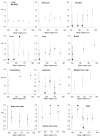Adult height and cancer mortality in Asia: the Asia Pacific Cohort Studies Collaboration
- PMID: 19889610
- PMCID: PMC4170779
- DOI: 10.1093/annonc/mdp363
Adult height and cancer mortality in Asia: the Asia Pacific Cohort Studies Collaboration
Abstract
Background: The observation that taller people experience an increased risk of selected cancers is largely restricted to Caucasian cohorts. These associations may plausibly differ in Asian populations. For the first time, we make direct comparison in the same analyses of the associations between height and a series of malignancies in Australasian (Caucasian) and Asian populations.
Methods: Analyses were based on the Asia Pacific Cohort Studies Collaboration of 506 648 study participants (408 381 Asia, 98 267 Australasia) drawn from 38 population-based cohort studies. Cox proportional hazards regression was used to estimate the relationship between height and cancer rates.
Results: A total of 3 272 600 person-years of follow-up gave rise to 7497 cancer deaths (4415 in Asia; 3082 in Australasia). After multiple adjustments and left censoring, taller individuals experienced increased rates of carcinoma of the intestine (men and women); all cancers, liver, lung, breast, 'other' malignancies (all women); and cancers of the prostate and bladder (men). No consistent regional (Asia versus Australasia) or sex differences were observed.
Conclusions: In the present study, taller men and women had an elevated risk of selected malignancies. These associations did not differ appreciably between Asian and Caucasian populations.
Figures



References
-
- Kuh D, Ben Shlomo Y. A lifecourse approach to chronic disease epidemiology. Oxford Medical Publications; Oxford: 2004.
-
- Gunnell D. Can adult anthropometry be used as a ‘biomarker’ for prenatal and childhood exposures? Int J Epidemiol. 2002;31:390–4. - PubMed
-
- Kannam JP, Levy D, Larson M, Wilson PW. Short stature and risk for mortality and cardiovascular disease events. The Framingham Heart Study. Circulation. 1994;90:2241–7. - PubMed
Publication types
MeSH terms
Grants and funding
LinkOut - more resources
Full Text Sources

